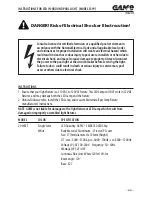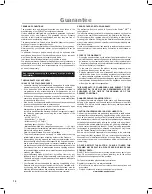
4
The pH will change slowly over the course of a week or two. The
number of bathers and the type of chlorine used are just two fac-
tors that will cause the pH to change. For this reason, pH should
be tested three times a week and adjusted as needed. See the
“Maintenance and Use of your Endless Pool Swim Spa” instruc-
tions found later in this guide for further details.
Once the pH is within range, move on to adjusting the calcium
hardness.
3) Balance Calcium Hardness (CH)
Ideal reading: 180ppm
Acceptable range: 175-250ppm
Raise with: Calcium Chloride (calcium hardness increaser)
Lower with: water containing less calcium (softened water)
Method of chemical application:
• Fill a clean, five gallon bucket with water and dissolve the
dosage of calcium into this water. Do not mix this solution
with your hands. Pour the solution in to the swim current,
and let the current circulate the water in the pool for a few
minutes. Wait a few hours, test again, and add more calcium
if necessary. Once again, always add less chemical than you
think will be necessary to effect the desired change.
Notes:
As with TA, many regions will have higher CH than what is speci-
fied by our recommended range. If it is available, partially filling
the pool with softened water will dilute the calcium content and
essentially lower the CH level inside the swim spa. If softened water
is unavailable, perhaps water tanked-in from an outside source
would be the best option for you. If this not possible either, we
would strongly suggest adding a “sequestering agent” which can be
purchased at any local swimming pool retail center. This chemical
helps the water hold all of its dissolved materials in solution, includ-
ing metals and calcium content. The main concern with having CH
levels too high is that the calcium may deposit out of solution—a
sequestering agent will help prevent this.
Calcium hardness will tend to slowly increase over time as water
evaporates from the swim spa and leaves its calcium behind.
Periodic testing of CH is detailed in the “Maintenance and Use of
your Endless Pool Swim Spa” instructions below.
MAINTENANCE AND USE OF YOUR
ENDLESS POOL SWIM SPA
We recommend getting into a routine that involves adding a meas-
ured amount of chlorine either after you swim or at the very least
every other day. This measured amount depends on pool use. One
person swimming every day for 30 minutes might add 1/2 cup of
Clorox after each swim. This small amount should maintain the
required 0.5 to 1.5 ppm chlorine residual. Heavier use and use by
children generally requires more chlorine. Adding 1 cup of Clorox
bleach raises the chlorine level by about 1 ppm. It is safe to swim
in any pool where the chlorine level is between 0.5 to 3.0 ppm
free chlorine.
If you intend to keep your swim spa at a temperature above 95ºF,
then the use of bromine should be considered. Bromine is a more
effective sanitizer at higher temperatures. The acceptable range of
bromine for your swim spa if 2.0 to 5.0 ppm. The easiest way to
introduce Bromine into your Swim Spa is by a floating feeder. A
floating feeder allows Bromine to dissolve at a slow and constant
rate. Remember to remove the floating feeder when the swim spa
is in use. Too high a bromine level can cause corrosion to the
swim spa.
RECOMMENDED MAINTENANCE SCHEDULE
Daily:
• Test for free chlorine (FC) after you swim, or at least a few
times a week. Add chlorine to maintain FC levels between
0.5 - 1.5 ppm. As you become familiar with the chlorine
demand for your pool, you will find that you may not have to
test for chlorine as frequently in order to maintain a mini-
mum level of 0.5ppm.
Twice a week:
• Check and adjust water level. Water should completely
cover the honeycomb grill where the current is produced.
Water 1/2” lower than this can create a choppy current and
may cause your skimmer to draw air into the plumbing lines.
Having the water level 1” or more higher that honey comb
grill will cause more water to get splashed out of the swim
spa, and may cause the air relief port on the top of the skim-
mer body to leak water.
• Test for pH at least twice a week. Broadcast (i.e. pour chem-
ical into current) pH increaser or pH decreaser to maintain
levels between 7.4-7.8.
Weekly:
• Test for total alkalinity (TA) once a week. Slug (i.e. pour
chemical in 4 spots around pool with water calm) TA
increaser or pH decreaser to maintain levels between 80-120.
If TA is too high, it is usually not necessary to decrease as it
merely serves as a buffer for the pH and will not cause dam-
age in the pool.
• Test for total chlorine (TC) once a week. If the test for TC
yields a result that is significantly higher than level of FC
(i.e. the solution gets noticeably more pink) then you have a
significant amount of combined chlorine (CC) in the pool
water. Combined chlorine generates a heavy chlorine odor,
and can cause bather discomfort in the form of eye and skin
irritation. If you have significantly more total chlorine than
you do free chlorine, then it is time to shock the pool (i.e.
add enough chlorine to get the FC between 3-5ppm, but
don’t swim until FC falls below 3ppm). Shocking the pool
should burn off the combined chlorine.
Every two weeks:
• Test for calcium hardness (CH) once every two weeks.
Predissolve calcium hardness increaser (i.e. fill a 5-gallon
bucket with pool water and dissolve calcium in bucket) then
pour the solution into the current to keep levels between 175-
250 ppm. If CH is too high, it can only be decreased by
adding water with less calcium (i.e. softened water).
• If you have an outdoor pool, or if you use stabilized chlorine
(i.e. sodium dichlor or sodium trichlor), test the cyanuric acid
(CYA) level every two weeks. Maintain levels between 20-
50 ppm. If CYA is above 80 ppm, the pool should be partial-
ly drained and refilled, or un-stabilized chlorine should be
temporarily used in place of the stabilized. If CYA is above
100ppm, the pool should be partially drained and refilled. If
you use bromine, then this step is unnecessary.
Every two months:
• Remove and clean the filter cartridge. After several uses, the
cartridge will need to be replaced, and new filter cartridge
can be purchased on our Customer Service website, myend-
lesspool.com.
SS Assembly 5-09 5/28/09 8:19 AM Page 6


































